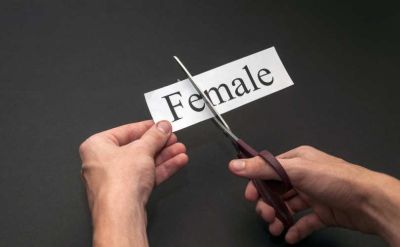
The second article by Freedom of Religion SA in a series on transgenderism — an issue that is making headlines around the world. In the first article FOR SA’s Michael Swain explained what transgenderism is and why we should be concerned
Around the world, transgenderism is fast gaining momentum and impacting virtually every sphere of society – politics, law, business, education, media, arts and entertainment, even religion and family life.
In the name of transgenderism, 60-year-old men identify as six-year old girls, and “men” now have babies and even breastfeed them (known as “chestfeeding”). (See http://time.com/4475634/trans-man-pregnancy-evan/)
Transgenderism says that men who self-identify as women, should be able to compete on women’s sports teams, or use women’s bathrooms, or share a room with females (e.g. in dormitories, or on school camps). Already in Canada, it is considered a “hate crime” (with a possible jail sentence) if you fail to call someone by their chosen personal pronoun (e.g. “he” instead of “she”, “ze”, etc). In New York, you can be fined up to $250,000 (R2.93-million) for committing the same “hate crime”. These are just a few examples of how the transgenderism agenda is playing out in everyday life.
In the first article in this series we looked at transgenderism and how it is different to the gender dysphoria. We now take a closer look at the ideology behind transgenderism, i.e. the set of beliefs through which people holding to or supporting this ideology see and interact with the world. Ideologies are important because they shape the world we live in and the world our children will grow up in – including the legislative and cultural norms that will govern that society.
Gender dysphoria, transgenderism and intersex people
As explained in our previous article, medical professionals have historically understood gender dysphoria as a (rare) psychological illness, describing persons who suffer discomfort or distress because of what they experience as a “mismatch” between their biological sex and the gender they more closely identify with (e.g. feel that they are actually a male trapped in a female’s body, or vice versa). Not all persons suffering gender dysphoria, identify as transgender however. In fact, they may continue to live in accordance with their biological sex for the rest of their lives.
A transgender person (literally translated as “moving between / across genders”), on the other hand, is someone who chooses – for whatever reason – to identify as a different gender than their biological sex (e.g. male instead of female), or more than one gender at different times (e.g. male today, and female tomorrow) or even at the same time (e.g. “two-spirit person”). In some instances, transgender persons identify as something else altogether, for e.g. “a yellow-scaled wingless dragonkin”, “an expansive ornate building”, “a plural being”, etc. (See for e.g. https://stream.org/google-far-left-lost-touch-reality/)
Transgenderism says that while biological sex is something that is innate and that one is born with, gender is fluid and that gender identity (whether male / female / something else) is something that one can choose and change – whether once-off, or multiple times throughout one’s life (or day!). In some instances, transgender persons will undergo hormone therapy and/or sex reassignment surgery to match their biological sex with their chosen gender – but in many instances this is not the case and so, while someone can physically look like a man, he can actually identify as a woman or something completely different altogether.
Importantly, a transgender person is not (necessarily) the same as an intersex person. An intersex person (sometimes referred to as “hermaphrodite”) is born with a reproductive or sexual anatomy that does not seem to fit the typical definitions of female or male, for e.g. female (external) genitalia but abnormally high testosterone levels for a female (such as in the case of South African athlete Caster Semenya). When doctors are uncertain about a newborn’s sex, blood tests, chromosome analysis and other medical tests can be done to make a correct diagnosis and determination of gender.
Transgender ideology
The ideology that drives transgenderism, is the idea that there are no objective truths – only subjective preferences. How you feel, is how it is – not only for you, but for everyone else who is forced to deny biological reality and accept (embrace) your version of reality. Those who don’t go along with this self-created reality, are typically labelled as “bigots” who must be silenced and/or punished.
The problem with transgender ideology, is that there is no logical end to the spectrum of possibilities (absurdities). A man can be a woman, a building, a pet, a computer, et cetera. And if a person can choose to be a different gender irrespective of the reality of their biological and genetic make-up, what stops them from choosing to be a different race, or a different height, or a different age?
As stated by Christian leader John Stonestreet in his book A Practical Guide to Culture: “Social construction is free to go anywhere our minds will take us … but this logical slippery slope can’t hold up under the weight of its own consequences.” For e.g. if a white male self-identifies as a black female, should “she” be able to benefit from BEE? If a 65-year-old male self-identifies as a six-year old girl, should “she” be able to enrol as a Grade-1 learner in the local public school? If a 15-year old girl self-identifies as a 70-year-old man, should “he” be able to receive an older person’s grant from the government? What if a person self-identifies as the world’s best pilot – would you allow him/her to fly your plane?
Transgender ideology is not only logically inconsistent, but has also proven potentially harmful or dangerous to the individuals involved. As we have already explained, transgenderism is purely subjective and exists solely in the mind of an individual – it is not something that can be diagnosed by a doctor. And it is just here where the problem lies: not only does the individual diagnose him-/herself, but “worse yet, the individual prescribes his/her own treatment” (John Stonestreet).
Increasingly, transgender individuals and parents of young children who experience a sense of gender confusion (which is actually quite normal) look to puberty blockers, cross-hormone therapy and ultimately sex reassignment surgery, to change their physical appearance to line up with their chosen gender. In this regard, two important points: First, studies show that 80-95% of children who suffer from gender dysphoria outgrow the gender confusion by the time they reach adulthood, eventually identifying with the gender corresponding to their biological; and second, studies also show that people who have had sex reassignment surgery, are 20 times more likely than average to die by suicide. These statistics should stop us in our tracks, and make us think much more carefully about the transgender ideology. Far from liberating people to be “their true selves”, this ideology leaves countless victims in its wake.
In this regard, it is helpful also to point to other examples of incongruency between biological fact and psychological perception, and the way in which we treat such instances. Think of a teenage girl who suffers anorexia but who believe she is terribly overweight. It is unthinkable that doctors, or anyone, would affirm her misdiagnosis of herself and encourage her to go on a diet! Why then, in the case of transgenderism, are we so quick to accept people’s (incorrect) self-diagnoses and worse, self-prescribed treatment?!
A Christian response to transgenderism
The Bible tells us that God did not create gender-neutral human beings, but male and female He created them — Gen, 1:27. Thus, gender is a gift from God, rather than something to be chosen and changed at will.
This is not to deny that there are men and women who genuinely struggle with gender-identity issues. As Christians, we are commanded to love, have compassion for and treat with dignity, all people – including those who believe or feel differently to us. The feelings of those who experience a sense of gender confusion are very real to them, and while it is not helpful to deny what they are feeling, we are to – graciously, and with much love and wisdom – point them towards the Creator who wonderfully and fearfully formed them in their mother’s womb, who has a plan for their lives and is good news for the searching, the broken and the hurting!
(We will look at this topic of a Christian response to transgenderism, which has been touched on very superficially above, in greater detail in a future article.)






